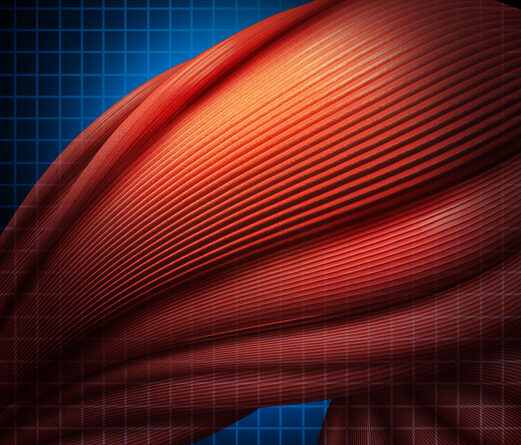
The Science Behind Muscle Growth
What causes muscle growth? Many wonder about this simple yet interesting question. We’re going to explain how and why your muscles grow in detail.
Muscle growth during exercise
During exercise, blood flow increases in order to deliver oxygen and nutrients to the working muscles. Blood vessels also increase in diameter to accommodate the increased volume of blood flowing through the capillaries. The extra blood supply gives rise to swelling in some parts of the tissue. Because the size of the muscle fibers remains constant, the swelling forces the fibers closer together. This causes the muscle to shorten temporarily. Then the muscle relaxes and returns to its normal length. Repeated cycles of shortening and relaxation cause the muscle fibers to swell further. Eventually, the muscle swells until it reaches its maximum capacity. At this point, no additional growth can occur. In contrast, endurance training involves exercising for longer periods of time. Endurance training does not involve shortening and relaxing the muscle like weight lifting or sprinting. Instead, it’s a steady-state where the muscle contracts continuously. Therefore, the muscle fibers remain swollen permanently. Over time, the muscle grows larger and stronger due to continuous stimulation. Endurance training is effective for building muscle strength.
Why muscles grow
Now let’s discuss the mechanism of muscle growth. There are two main theories about why muscle cells grow: hypertrophy (increase in muscle mass) and hyperplasia (addition of new muscle fibers). We’re going to explain these two theories, starting with the first one—hypertrophy.
Hypertrophy is caused by an accumulation of a protein called myofibrils. Myofibrils are bundles of proteins that connect muscle fibers. When the body needs more muscle, it builds up extra amounts of myofibrils. This process is known as accretion. Accreted muscle fibers are called new muscle cells. These new cells are added to existing muscle cells. New cells are created by dividing existing cells. This is a natural phenomenon that happens all the time without any external intervention. It is a process that occurs every time a cell divides. However, the number of muscle fibers in the human body is limited. If new muscle cells are produced too quickly, the available space for other cells is taken away. To prevent this, the cells are destroyed. This process is known as apoptosis. Apoptosis is a type of cell death that occurs naturally. In fact, it is a programmed process that every cell undergoes. This process is necessary because if the cells were allowed to live forever, they would eventually make a mess of the tissues. This is because cells are constantly dying and being replaced. If the process is stopped, the body would be unable to function properly. Thus, the cells are eliminated. In addition, if new muscle fibers were to proliferate indefinitely, they would eventually destroy all of the original muscle fibers. This is why the human body has a limit on the total amount of muscle fibers that can exist. If this limit is exceeded, the cell will die off naturally. To ensure that the cells are not overproduced, the body keeps track of how many muscle fibers there are. The brain sends signals to the muscles to tell them when to stop producing new muscle fibers. This signal is known as a brake. It tells the body to slow down the production of new muscle fibers. However, the brain doesn’t know exactly how much muscle mass should be maintained. That’s because, in the long run, muscle growth is a balancing act between the need to produce enough muscle and the need to maintain a certain level of muscle mass.
The second theory of muscle growth, hyperplasia, occurs when the body produces excess muscle fibers. Muscle fibers are made of a special substance called a sarcomere. Sarcomeric proteins are arranged in a precise order. Muscle fibers are composed of these ordered proteins. A muscle fiber is a bundle of hundreds of thousands of sarcomeres that contract together. Sarcomeres are built from the same basic components. For example, the amino acid lysine forms the backbone of the sarcomere. Amino acids are the building blocks of proteins. The order of the amino acids determines the shape of the protein. When the body needs more muscle, the body makes extra copies of the sarcomere. The extra copies are called extra nuclei. The extra nuclei are added to the muscle fibers. The extra muscle fibers add to the mass of the muscle. This is known as hyperplasia. This theory of muscle growth was proposed by Dr. Stuart Hamerstrom in the 1970s. He published his findings in the Journal of Applied Physiology. This idea of adding new muscle fibers to existing muscle fibers is not the only way to increase muscle size. There are other ways to do it. One of these methods is called neural growth. Neural growth involves the use of electrical impulses. When the body needs more muscle, the central nervous system (CNS) sends a message to the muscle to contract. The muscle then contracts and increases its strength. This is a very simple method of muscle growth.
How steroids work on muscle growth
We absolutely disapprove of the use of steroids because they’re not worth the risk. But out of interest, let’s talk about how they work.
Steroids mimic the natural process of making new cells in our bodies. When you exercise. Earlier we talked about myocytes (= muscle cells). The body produces certain chemicals known as myokines that tell the rest of the body how hard you worked out. Myokines are released by myocytes during muscular contractions. They travel throughout the body to send signals back to the brain saying, Hey, I’m tired and sore. That’s why we feel good after exercising. But sometimes, when you work out too much, the myokine production gets thrown off balance. In this case, the myokines don’t get to their destination properly and end up causing inflammation in places like joints and tendons. As a result, you get joint pain and tendonitis. This causes you to stop going to the gym and forces you to spend even less time doing exercises. And since your body isn’t getting enough stimulation, it stops producing myokines entirely, leaving you feeling weak and exhausted.
Steroid users have a lot of extra myokines floating around in their blood because they’re constantly being pumped full of them. This allows the body to produce more myokines, which leads to more efficient signaling between the brain and muscles. The result? More muscle mass. This is how steroid users get bigger.
Now we’ll look into why the use of steroids is so dangerous.
To understand this, you must know that every cell in your body contains DNA. This is the blueprint that tells the cell what to do. If you want to grow taller, you can change the DNA inside the genes that control your height. Steroids do this as well, but not to grow tall—they do it to build muscles. By changing the way your DNA works, it will force your muscles to give you stronger, more powerful muscles. This is called gene expression.
The problem is that this is illegal. Because of this, there is no scientific research to show that it actually works.
Now, let’s talk about the side effects of steroids. They’re dangerous. They’re addictive. They cause cancer.
Side Effects:
- Hair Loss.
- Liver Damage.
- Cancer Risk.
- Heart Disease.
- Stroke.
- Depression.
- Kidney Failure.
- High Blood Pressure.
- Brain Damage.
- …
References:
- The Human Body, by Dr. Stuart Hamerstrom.
- The Anatomy of the Muscles, by Dr. John S. Brannon.
- The Cell, by Dr. Richard P. Feynman.
- The Molecular Biology of the Gene, by Dr. James D. Watson.
